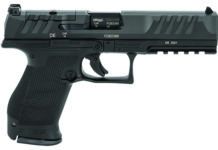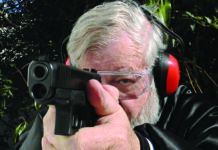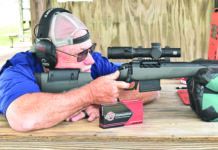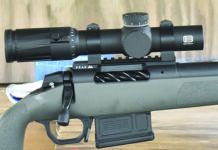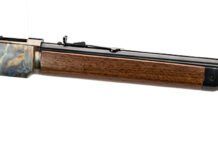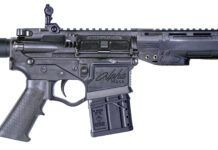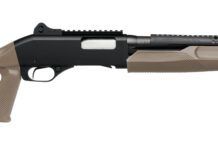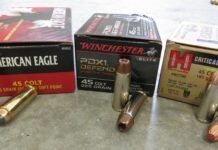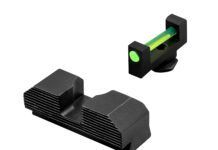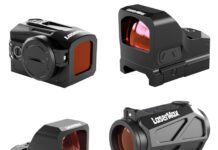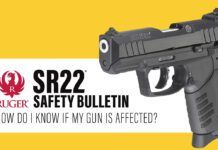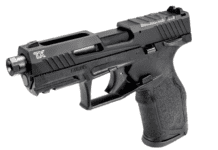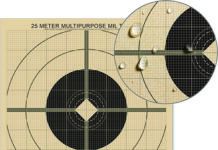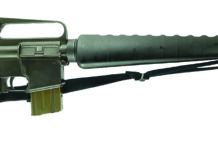In the several years that I’ve been teaching gunsmithing, it seems like almost all of my students have asked at one time or another for little tips they can use in their day-to-day work.
For some, the question may be a simple thing like: “How important is a vise pad?” For others, it might be: “What do I do about boogered-up screw slots?” It really doesn’t matter what the question is, because most of us in the trade are actually anxious to help those who want to learn.
None of these items I’ll discuss with you are complicated enough or take enough time and experience to devote a full book to, so I decided that I would combine all of my favorite shop tips into one chapter.
The Ultimate File Cleaner
Cleaning files with a file card or wire brush is fairly ineffective in many cases and can accelerate the dulling of your best files. Here’s a trick I learned years ago from a gunsmith in Inglewood, California.
Flatten the neck of a large-caliber cartridge case and push it against the file’s teeth parallel to their cut. Several passes will shape it to that particular file and you will find that it will remove even the most tenacious particles. It will clean down to the bottom of the cuts, and will find its way into your favorite toolbox.
Vise Pads
I’ve purchased many vise pads from commercial sources and find that they don’t last long, or that they aren’t suited for the task at hand.
The least hardy are the thin sheets of lead, as they are cleaved in two by clamping anything with a line contact such as a gun barrel. I do keep some lead sheets around, but I’m selective about using them.
Lead ingots, which you have around for your bullet casting, work well, although they aren’t as easy to handle as sheets of lead. I often machine reliefs in them to fit the occasion, figuring the worst that could happen is that I would have to melt them into ingot form again. I keep one around to fit oddly-shaped barrels as on the Smith and Wesson Model 19, (with its ejection rod shroud) and Colt Pythons. These special blocks are sacred and don’t get used for any other purpose.
Some Brownells Powdered Rosin makes the ingots grip blued barrels without any damage to the finish. The most “damage” that I’ve seen to barrels removed this way is some of the lettering on the barrel getting filled with lead. It is easily removed with a sharp pin or the point of an X-Acto knife blade.
I often paint on a coat of mold-release agent and make Acra-Gel casts of a particular object that has to be clamped repeatedly. As it takes time for the gel to harden, this is only useful when I think ahead.
Powdered Rosin
Powdered rosin is handy around any gun shop for a variety of uses. The main use around my shop is to prevent barrels and other round pieces from slipping when clamped in a vise and subjected to torque. The rosin will provide the friction needed when taking rifle or pistol barrels from their receivers or in screwing them back in. So far, it has always prevented the lead blocks I use between the barrel and vise from scarring the finish.
It can be used as an exceptional flux for melting lead alloys, albeit an expensive one when compared to things like old soldering paste, paraffin wax, or commercial bullet-casting fluxes. It will, of course, act as a good soldering flux when you are out of any other cheaper kind.
Repairing Screw Slots
Peening the burrs and displaced metal on screw heads can effectively renew them to the good appearance essential to any firearm.
To hold the offensive heads while preparing them for restoration, I use a steel block, drilled and tapped for all the common screw threads I use (and some I don’t use). I have two of each size; one threaded to the top, and one in which I have drilled a slight counterbore to clear screws not threaded all the way to the head.
Run the offending screw into the proper hole and carefully peen the burrs back into place. Flat-headed screws are the hardest to do, as they require peening the entire top surface of the head and filing it flat. Peening enough to remove irregularities in the head will call for some cleanup of the slot. This is easily accomplished with auto ignition point files or needle files which are available from Brownells. The supply house also sells screw-slot files which have toothed edges and smooth “safe” sides. The screw-slot files are primarily useful in filing new slots when making screws, but they’re also helpful in reclaiming slots. Be careful not to widen the slot any more than necessary. This sticks out like a sign around your neck saying “Amateur.”
Filing the top of the head back into shape and polishing it will make a stainless-steel screw ready to install, or a carbon-steel screw ready to blue. To bring it to its original condition, I usually use my buffer-mounted Scotchbrite wheel on the screw head, followed by the cloth wheel with white rouge. Holding the screw while polishing it is simplified by using a pin vise, or make a much handier tool by installing a handle on a small drill chuck. I use the drill-chuck tool to hold screws and pins while buffing, peening, sandblasting, or other operations around the shop.
Blue the carbon-steel screws with any of the popular blueing solutions. The head will usually take the blueing solution well if you clean it with a degreaser and detergent and water. It’s not as hard to get a good blue on a screw head as it is a gun; the area isn’t large and flat, and the screw head will respond to brushing with a bristle brush you wouldn’t dare use on a firearm that has been just polished.
Making a Hand Vise
I’ve never seen a hand vise that proved to be as useful as one made from an extra drill chuck. Okay, I know they are for different purposes in most cases, but I’ve never really used my hand vise much and my students and I use the hand-held drill chucks quite often. I made three sizes which cover everything from pins up to 1/4-inch-diameter rod stock.
Start by fitting a bolt into the rear threads of the chuck, and cutting the bolt off at about 21/2 or 3 inches total length. Use a lathe to shape a piece of wood into a handle, or use a plain piece of doweling. If a lathe is not available, the handle can be drilled and shaped entirely on a drill press or whittled by hand. If the threaded shaft is installed first, you can often turn the piece in the press while holding a grinder against it to simulate the effects of a lathe.
The same thing can be done for sanding it. I use strips of emery cloth like a shoeshine rag, letting the drill press or lathe do the real work for me. If the wood used is one of the oily types like walnut, teak, or rosewood, you won’t have to put a finish on the wood. It will darken with time, however, as it picks up dirt and grease.
The threaded shaft can be glued into the handle with any type of glue, but I prefer Brownells Acra-Weld or Acra-Gel. If you don’t have any cyanoacrylate glue, a drilled hole and roll pin will lock the shaft in just fine.
It is unnecessary to use the key to a keyed chuck since the jobs you’ll use this tool for usually don’t require such a tight hold. The little chucks sold for use with Dremel tools are just about the right size for your smallest hand chuck, and the ones made for quarter-inch drills are the right size for the medium-size vise.
Lengthening Coil Springs
Pulling coil springs in order to lengthen them will only introduce overstressed areas which will collapse and ruin the performance of the spring. The first spot to stretch will be weakened and will continue to be the spot which stretches. This is a no-win situation which is best avoided. So what do you do?
Coil springs can be successfully lengthened by peening them in a controlled manner with a ball-peen hammer. I start by measuring the relaxed length of the spring in order to quantify the growth, then I measure the inside diameter to more easily pick a piece of drill rod or a pin punch to fill the inside of the spring. This “filler rod” is the key to lengthening the spring without exceeding the metal’s yield point in any location. You can use the shank end of a drill if you don’t have the right- size drill rod. I never throw away a broken or used-up drill bit if its shank is in good enough condition to be used for a gun pin or to fill the inside of a coil spring.
You will need a hard steel surface onto which to place the filled spring while rapping it with the flat end of a ball-peen hammer. I make the filler rod fit the inside of the spring as tightly as possible without having to pull hard to remove the rod. Pulling an overtight rod from the spring might negate all your lengthening work if it stretches the spring while coming out.
Place the side of the filled spring on the hard steel surface and rap it sharply with the hammer while rolling the spring and filler rod. Be sure to keep moving the impact point of the hammer up and down the entire length of the spring while rotating it evenly. You should be able to judge the growth of the spring by watching the space between the coils growing. It is essential that you move the hammering about—always seeking the places where the coils are more tightly packed. The spring will grow slightly in diameter, but not enough to matter in 99 percent of the jobs.
This growth will usually be only one or two thousandths of an inch, but will help you by loosening the spring on the filler rod. Removing the rod from the spring frequently to measure the growth, I repeat the process until I have a spring that does the job. I’ve never had a spring fail that was done this way.
Incidentally, if you don’t have a collection of springs, start one. I never throw away a spring, because I’ll need it as soon as the garbage truck clears the driveway.
If you collect springs, you will eventually have a collection of tangles. The easiest and fastest way to untangle coil springs is to drop the mess on a hard surface and watch them scatter. At a plant I ran, we had “spring separation boxes,” used to contain the overactive members of the spring clumps which tend to run for cover like roaches hearing a light switch. Very few tangles can resist this trick.
Allen Head Screws The Easy Way
Allen head or hex sockets for any purpose can be made easily in the shop. They’re quite handy for things like full-length recoil rods, or even your own custom-made hex-socket screws.
Hex sockets are extremely easy to make, but the mere thought of doing it seems to discourage most people. Even most machine shops don’t know they can make their own. It’s done by forcing a tool called a “broach” into a drilled hole, thereby shaving the corners of the hex down into the bottom of the hole. To my knowledge, broaches for this purpose aren’t available over the counter. It just isn’t a common practice to do something which we all have left up to some mysterious process by screw companies.
I have made hex-socket broaches from die pins (which are about as hard as steel comes), using a spin indexer on a surface grinder. This was an unnecessary nuisance, as I learned while making special wrenches for my handgun-security devices. I needed a hole in the ends of some hex wrenches and couldn’t anneal them with normal methods.
Good hex keys are made of air-hardened steel which doesn’t cooperate with normal annealing practices, so I decided to simply let that work for me. These hard steel wrenches can be cut with a Dremel cutoff wheel, and be made to serve as excellent broaches. Be sure to make the cut end flat and square to the axis of the hex rod, with all the corners being sharp and clear-cut.
First decide what size hex socket you need, and pick out the hex wrench you’ll use for a broach. Measure it across the flats (the shortest measurement) and drill a hole of that size where you want the hex socket, to a depth of about .200 inch. I slightly chamfer the top of the hole to help center the broach. This also makes the finished result look like the best hex socket you ever saw.
Place the piece in which you want a hex socket with its other end solidly against an immovable object, or clamp it between two pieces of lead to protect the sides and keep it from moving during some serious hammering. If the hex you choose is very small, you will need to use a very short piece of the hex wrench mounted into a steel rod approximately 1/4 inch in diameter. You will need only a length equal to about three times the major diameter of the hex sticking out of the holder. This holder should be of a very hard steel like 4140 or better. I use drill rod for this purpose.
Position the hex wrench/broach piece over the hole, align it coaxially with the hole, and tap it into the hole about 1/16 inch with a steel hammer to get it started. Check the alignment before going in farther and do any straightening required to bring it back into line with the axis of the hole.
By now, you’ll need to grip the broach with some type of pliers, as the piece you use should not be long enough to invite bending during hammering. With everything aligned, drive the broach in to the bottom of the hole. You’ll know when you reach the bottom.
Pull the broach out and you have a good hex socket. If the broach sticks in the hole, clamp it with Vise-Grip pliers and carefully tap it until the broach comes out. Very few machine shops can make an Allen socket that easily.
Rebound-Rod Fitting
Most law-enforcement agencies will not allow trigger stops on their weapons under the premise that the stop might become unadjusted and prevent the gun from firing.
This leaves the gun without a good-feeling trigger and prompts people to design an innocent-looking stop and name it something else. Smith & Wesson did this for the Model 28 double-action .357 large-frame Highway Patrolman, calling the trigger-stop replacement a “rebound bar” (since it is inside the rebound slide). It’s a steel rod that limits how far the rebound slide can move and, subsequently, the trigger’s travel. It’s a solid piece and can’t change—except in a direction favoring the safety of the policeman.
Fitting it can be a study in patience, as the perfect fit with the gun open will keep it from firing when the sideplate is installed. The sideplate has a hole into which the rebound-slide stud fits. With the sideplate off, the stud is flexed toward the rear of the pistol by the rebound spring, and forced back into proper alignment when the sideplate is reinstalled. The stud hole in the sideplate forces the stud back into proper position, and the rod, which fit before, doesn’t fit anymore. Solution: File the rod shorter and retry the gun with the sideplate back on. If you have filed off a little too much, peen the rod lightly with a hammer or crimp the rod with a pair of wire cutters. Done prudently, this gives you another chance without having to start over with another rod.
If you remember the fact that the rebound-slide stud is flexed when the sideplate is removed, it makes the job much less frustrating. There is no way to explain the feel of a properly adjusted trigger stop to one who hasn’t experienced a good one. That’s one of the subtle touches that highlights the difference between a superb trigger job and an average one.
Compression Spring-Rate Measuring Jig
Making a jig to measure a spring’s rate isn’t difficult, and can be done with little in the way of tools. There are several ways that come to mind, and I’ll go through them all before you need to make a decision.
The need for a jig disappears if you have a postal-type scale available, as it is no real trick to measure the spring. (Apply downward force, and measure it with that force still applied.) However, if you want to really get down to quality measurement, you will need a jig that allows you to utilize the accuracy of your trigger-pull scales. Somehow, that seems more like gunsmithing and less like handling mail. The problem boils down to converting a tensile force (pull) into a compression force (push). Nothing new about this; outboard-boat steering dampers are a good example of this technology at work.
First, you’ll need flat washers and either welding rod or the proper size and weight cotter pins. The only tools needed will be long-nosed pliers and a soldering iron (for the cotter-pin type) or wire cutters and an acetylene torch (for the washer-and-wire type). It is also feasible to make the washer-and-wire type using a soldering technique instead of welding the metal. The size of the coil spring to be tested dictates the size of the jig, so different sizes may have to be added to your toolbox from time-to-time.
Click here for American Gunsmith Website


